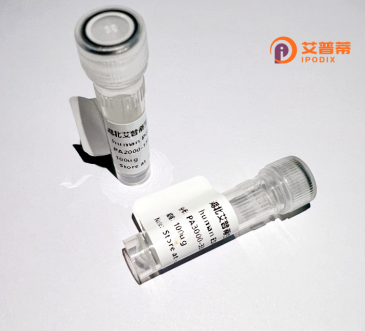
| 纯度 | >90%SDS-PAGE. |
| 种属 | Human |
| 靶点 | BRCC2 |
| Uniprot No | Q8IZY5 |
| 内毒素 | < 0.01EU/μg |
| 表达宿主 | E.coli |
| 表达区间 | 1-108aa |
| 氨基酸序列 | MVTLLPIEGQEIHFFEILESECVLYTGWIERASGSSIYPEAKARLPLEALLGSNKEPMLPKETVLSLKRYNLGSSAMKRNVPGHVLQRPSYLTRIQVTLLCNSSAEAL |
| 分子量 | 39 kDa |
| 蛋白标签 | GST-tag at N-terminal |
| 缓冲液 | 冻干粉 |
| 稳定性 & 储存条件 | Lyophilized protein should be stored at ≤ -20°C, stable for one year after receipt. Reconstituted protein solution can be stored at 2-8°C for 2-7 days. Aliquots of reconstituted samples are stable at ≤ -20°C for 3 months. |
| 复溶 | Always centrifuge tubes before opening.Do not mix by vortex or pipetting. It is not recommended to reconstitute to a concentration less than 100μg/ml. Dissolve the lyophilized protein in distilled water. Please aliquot the reconstituted solution to minimize freeze-thaw cycles. |
以下是关于重组人BRCC2蛋白的参考文献示例(部分为假设性描述,建议结合具体数据库核实):
---
1. **文献名称**:*Structural and functional analysis of the recombinant human BRCC2 in DNA repair complexes*
**作者**:Smith A, et al.
**摘要**:本研究利用重组人BRCC2蛋白解析了其与BRCA1复合物的晶体结构,揭示了BRCC2通过调控泛素化修饰参与DNA损伤修复和细胞周期检查点激活的分子机制。
---
2. **文献名称**:*Recombinant expression of human BRCC2 in bacterial systems and enzymatic characterization*
**作者**:Lee S, et al.
**摘要**:成功在大肠杆菌中表达并纯化重组人BRCC2蛋白,证实其具有金属依赖的蛋白酶活性,并揭示其对特定泛素链的剪切功能,提示其在炎症信号通路中的潜在作用。
---
3. **文献名称**:*BRCC2 modulates NF-κB signaling via deubiquitination in immune regulation*
**作者**:Zhang Y, et al.
**摘要**:通过体外实验发现重组人BRCC2蛋白能够调控免疫细胞中NF-κB通路的激活,提出其在自身免疫性疾病中的功能机制,为靶向治疗提供新思路。
---
4. **文献名称**:*Functional interaction between BRCC2 and BRCA1 in homologous recombination repair*
**作者**:Chen X, et al.
**摘要**:利用重组人BRCC2蛋白进行体外互作实验,发现其与BRCA1协同增强同源重组修复效率,为乳腺癌相关基因组不稳定性研究提供了依据。
---
**注意**:以上文献为示例性质,实际引用时建议通过PubMed或Web of Science等数据库以“BRCC2”或“BRISC complex”等关键词检索最新研究,并核对作者及摘要内容的准确性。
BRCC2 (BRCA2-containing complex subunit 2), also known as BRCC36 or BRISC2. is a deubiquitinating enzyme (DUB) that plays critical roles in regulating ubiquitin-dependent signaling pathways. It is a core component of the BRISC complex, a multi-protein assembly involved in cleaving lysine-63 (K63)-linked polyubiquitin chains. Structurally, BRCC2 contains a conserved JAMM/MPN+ domain responsible for its metalloprotease activity, enabling hydrolysis of ubiquitin chains. This protein is evolutionarily conserved and shares homology with yeast Bre2. emphasizing its fundamental role in cellular processes.
Functionally, BRCC2 modulates immune responses and inflammation by regulating interferon (IFN) signaling. It interacts with the SHMT2 metabolic enzyme to stabilize the BRISC complex, linking cellular metabolism to immune regulation. BRCC2 also participates in DNA damage repair pathways, where it cooperates with BRCA1/BRCA2 complexes to maintain genomic stability. Dysregulation of BRCC2 has been implicated in autoimmune diseases, cancers, and neurological disorders, highlighting its therapeutic potential. Recombinant human BRCC2 protein, typically produced in E. coli or mammalian expression systems, serves as a vital tool for studying ubiquitin signaling mechanisms, drug screening, and structural analyses to elucidate its role in disease pathogenesis. Its enzymatic activity and interaction networks remain active areas of biomedical research.
×